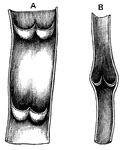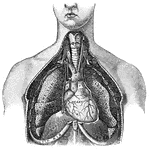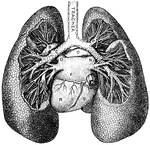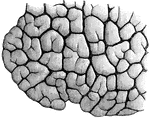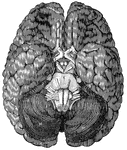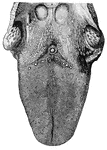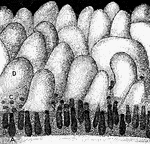
Glands and villi of the small intestine
"A, B, glands seen in vertical section with their orifices at C opening upon the membrane…

Transverse section of the small intestine
"In the figure on the left are seen the artery and vein of a villus. In the right figure are represented…
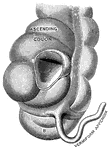
Vermiform appendix
"A, a portion of the colon laid open to show the valve between the large and small intestine;…

Lateral section of the chest
"A, a muscle which aids in pushing the food down the esophagus; B, esophagus; C,…

Muscles and Blood Vessels
"Principal Muscles on the Right, Certain Organs of the Chest and Abdomen, and the Larger Blood Vessels…

Arteries
"The Right Axillary and Branchial Arteries, with Some of their Main Branches." — Blaisedell, 1904
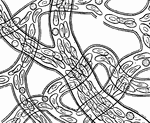
Circulation of blood
"Showing how the circulation of blood in the web of a frog's foot looks as seen under the microscope."…

Blood vessels of the brain
"Arteries and their Branches at the Base of the Brain." — Blaisedell, 1904
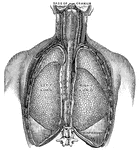
Lungs
"Relative Postion of the Lungs, the Heart, and Some of the Great Vessels belonging to the latter. A,…

Diagrammatic view of an air sac
"A, epithelial lining wall; B, partition between two adjacent sacs, in which run capillaries;…

Capillaries of the Air Sac
"Diagram showing the capillary network of the air sacs and origin of the pulmonary veins.. A,…

Outer skin
"A Layer of the Outer Skin from the Palm of the Hand. Detached by maceration." — Blaisedell, 1904
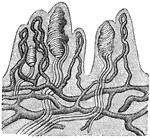
Papillae of the skin
"In each papilla are seen vascular loops (dark lines) running up from the vascular network below; the…

Surface of the palm
"Surface of Palm of the Hand, showing Openings of Sweat Glands and Grooves between Papillae of the Skin.…

Cross-section of a human hair
"Cross-section of One Half of a Human Hair. A hair is made up of horny cells of the outer layer of the…

Surface of a nail
"Concave or Adherent Surface of the Nail. A, border of the root; B, whitish portion…

Longitudinal seciont of a fingernail
"A, last bone of finger; B, true skin on the dorsal surface of finger; C,…

Sweat gland
"The convoluted gland is seen surrounded by fat cells and may be traced through the true skin to its…

Vertical Section of the Back
"The spinal column below the twelfth dorsal vertebra at A has been removed, as well as the…
Nerve Cells
"Nerve tissue is really made up of a great number of distinctive units called nerve cells.…

Nerve Cells of the Brain
"Wherever nerve cells are abundant, the nerve tissue has a gray color; in other places, it looks white.…
Portion of a medullated nerve fiber
"The axis cylinder is in the center. On either side is seen the medullary sheath, represented by dark…
Neuron
"Showing a motor cell with its long, unbranched process (with two little lateral offshoots), with motor…

Nervous System
"Diagram illustrating the General Arrangement of the Nervous System. (posterior view.)" — Blaisedell,…
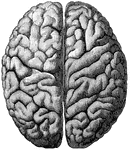
Cerebrum
"The Upper Surface of the Cerebrum. Showing its division into two hemispheres, and also of the convolutions."…
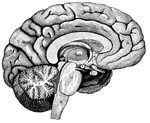
Left Half of the Brain
"A,frontal love of the cerebrum; B, parietal lobe; C, parieto-occipital lobe;…
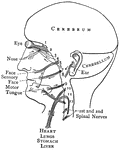
Distribution of the Cranial Nerves
"The cranial nerves are thus arranged in pairs: 1, olfactory nerves, special nerves of smell; 2, optic…
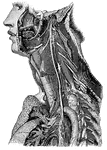
Trunk of the Pneumogastric Nerve
"Showing its distribution by its branches and ganglia to the larynx, pharynx, heart, lungs, and other…
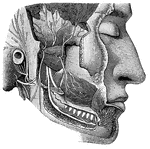
Cranial Nerves
"Dental Branch of One of the Divisions of the Fifth Pair of Cranial Nerves, supplying the Lower Teeth.…

Sympathetic nerve
"The Cervical and Thoracic Portions of the Sympathetic Nerve and their Main Branches. In the center…

Plexuses of the Sympathetic Nerves
"Showing the distribution of some of the great plexuses of the sympathetic nerve in the lumbar and sacral…
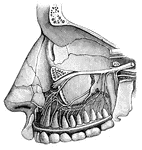
Cranial Nerves
"Dental Branches of One of the Divisions of the Fifth Pair of Cranial Nerves, supply the Upper Teeth."…

Superficial Nerves of the Head
"Showing some of the superficial nerves on the left side of the neck and the head. A few superficial…

Superficial Nerves of the Forearm and Hand
"Superficial, or Cutaneous, Nerves on the Back of the Left Forearm and Hand." — Blaisedell, 1904
Nerve trunks
"The Main Nerve Trunks of the Right Forearm, showing the Accompanying Radial and Ulnar Arteries. (Anterior…

Great Nerve
"A Great Nerve (Crural) and its branches on the Front of the Thigh. The femoral artery with its cut…
Great Nerve
"A Great Nerve (Posterior Tibial) on the Back of the Leg, with its Accompanying Artery of the Same Name."…

Great Nerve
"A Great Nerve (Plantar) and its Branches which supply the Bottom of the Feet. Note the cut tendons…

Papilla of the skin
"A Papilla of the Skin, with a Touch Corpucle. Highly magnified." — Blaisedell, 1904
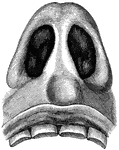
Nasal cavities
"Nasal Cavities, seen from Below. The sense of smell is located in the membrane which lines the cavities…
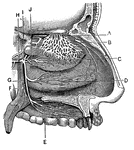
Nerves of the Nostril
"A, branches of the nerves of smell; B, nerves of touch to the nostrils; E, F,…
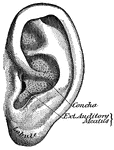
Pinna
"The outer ear consists of a plate of gristle, shaped somewhat like a shell, known as the pinna, or…
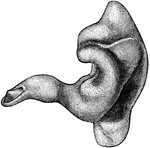
External auditory canal
"A Cast of the External Auditory Canal. The auditory canal is a passage in the solid potion of the temporal…
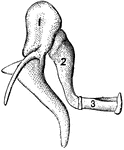
Bones of the Ear
"1, malleus, or hammer; 2, incus, or anvil; 3, stapes, or stirrup." — Blaisedell, 1904
